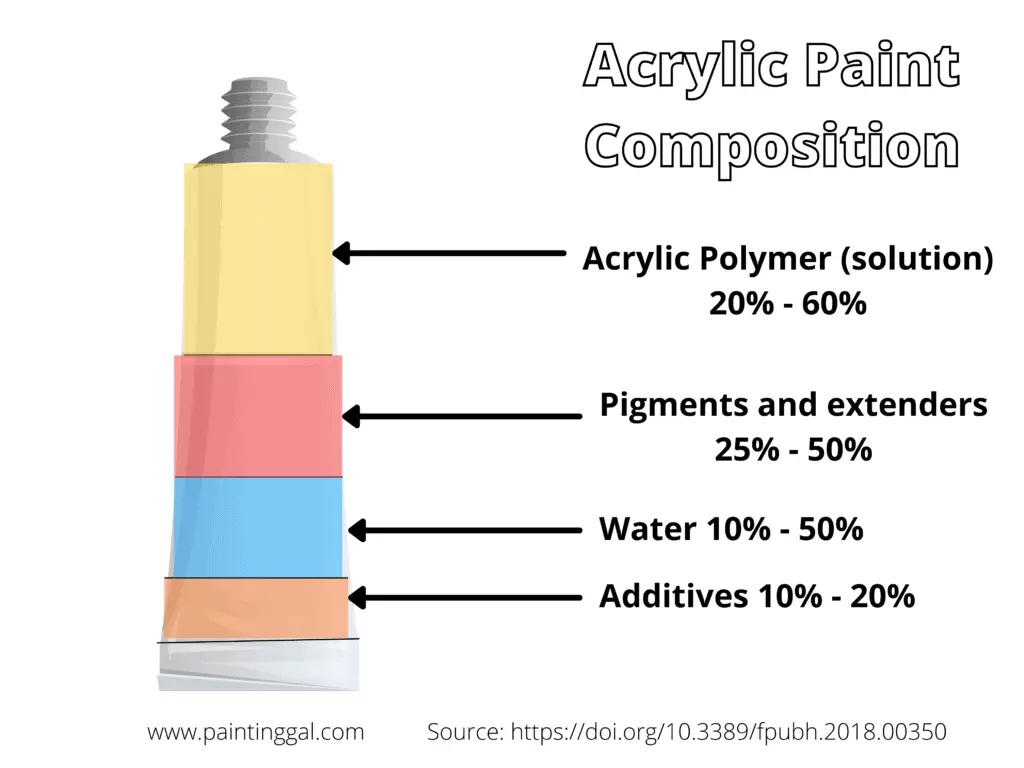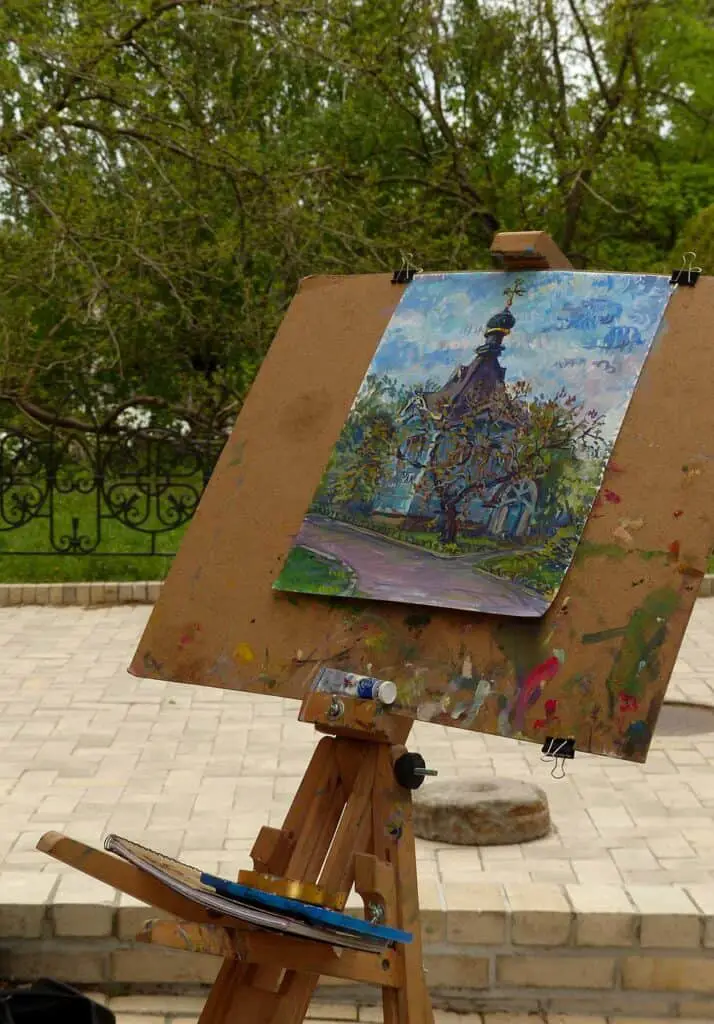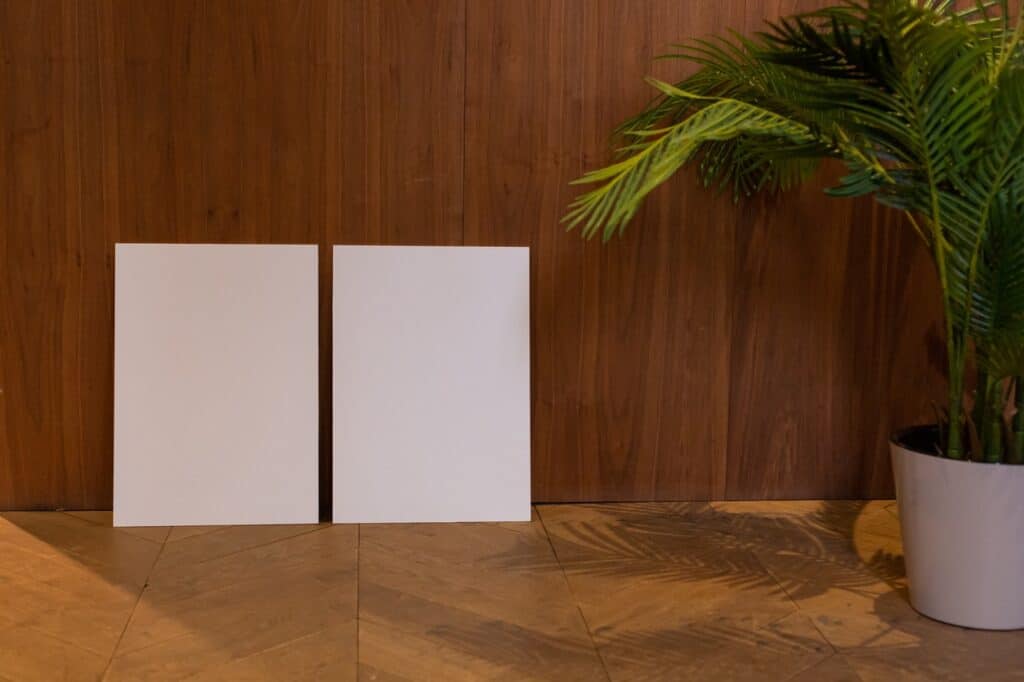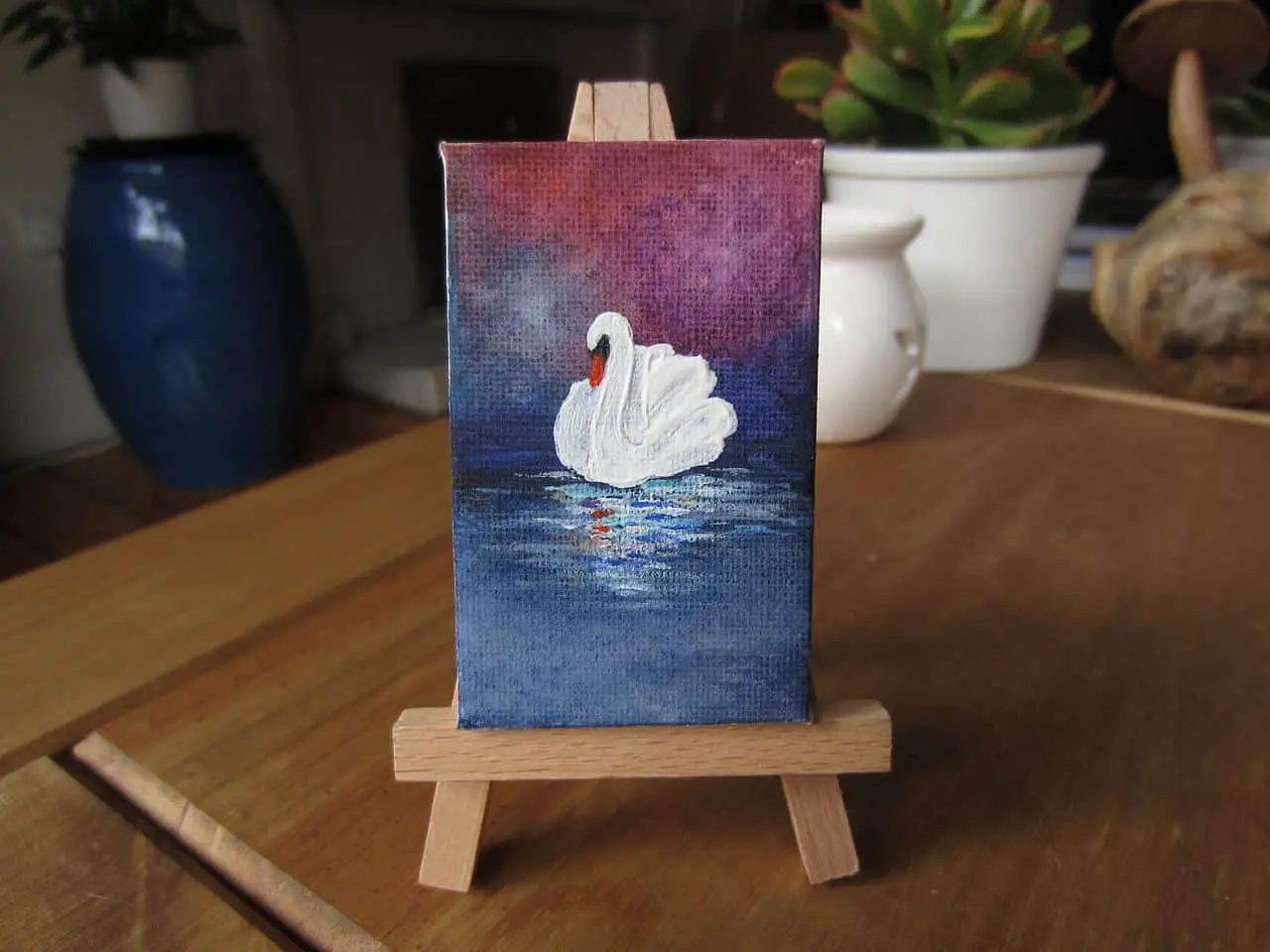As an acrylic artist, you may have heard the term acrylic paint curing. Especially in the case of varnishing, sticking to a surface, and paint durability. So you might wonder how long it will take for acrylic paint to cure.
On average water-based paints like acrylic paint cure within one to two weeks in temperatures from 68ºF (20ºC) to (77ºF) 25ºC. Relative humidity as low as 50% is needed to cure acrylic paint film. This means acrylic paint cure best in hot, low-humid conditions.
Acrylic paint passes different stages before fully curing. Curing makes the acrylic paint film hard and safe to handle stresses.
How long it will take acrylic paint to cure?
Acrylic paint can take 1 to 2 weeks or more to cure depending on the thickness of your paint film. When the thickness is high, the curing time will be high. The best environmental conditions for curing are temperatures between 68ºF (20ºC) to 77ºF (25ºC) and 50% relative humidity.
Curing involves tightening the paint film. It happens when acrylic paint film has no water or other volatile liquids in it. When curing acrylic polymer binder particles come more closely together to form a uniform coherent paint film. It takes more time than the time taken to evaporate all the water in the paint film.
As curing time varies for different compositions of acrylic paints, I asked different manufacturers how long will it takes for their acrylic paints to cure or form a coherent paint film. Here is what I got to know.
Curing time depends on the exact type of acrylic paint and its formula, combined with how thickly it is applied and its drying environment (temperature, and humidity). Thin films of “Regular” drying artist-grade acrylic paints will be dry and mostly fully “cured” within a week, perhaps less. Our OPEN Acrylics could take a month to fully cure as they are slow-drying products.
Scott Bennett, Materials Specialist for Golden Paints
So if you are using Golden acrylic paints, they will be cured or fully dry within a week, if applied thinly. Thick paint layers may take longer.
Curing time varies, due to factors such as temperature, humidity, surface, and artist application. Temperatures of 70oF (21ºC)to 85oF(29.4ºC) and humidity under 75% are ideal for drying and curing.
Jennifer VonStein from Chroma
As already said before, drying and curing times can vary on different factors. These can be the relative humidity, surface, temperature, thickness of paint application, and airflow. If you want to learn more about the factors that affect drying, you can read the following article: Why is acrylic paint not drying? (5 influencing factors).
Composition of acrylic paint
Before we move on to the next sections it is important to know the composition of acrylic paint.

Acrylic paint is made up of acrylic polymer binder, pigment, fillers (maybe), water, and other additives.
- Acrylic polymer binder: Act as the glue that holds the paint together
- Pigment: Give color to acrylic paint
- FIllers: Added by some manufacturers to extend the paint and reduce the cost. Fillers do not provide any value to the artist.
- Water: Act as the vehicle of acrylic paint. It keeps acrylic paint liquid inside the paint tube or the container. Helps smooth paint application.
- Additives: Additives such as dispersing agents, anti-settling agents, and emulsion stabilizers are added to keep the acrylic paint stabilized inside the paint container. Coalescent solvents are added as plasticizers to dry paint into a coherent continuous paint film.
Process of acrylic paint drying and curing
If you are interested in knowing what happens to acrylic paint when they dry or cure, this section is for you.
Acrylic paint drying has two phases. These phases are relatable to any water-based paint. These two phases are evaporation and coalescence.
Evaporation
Evaporation is the 1st phase of acrylic paint drying. In this phase, all the water in the acrylic paint will be evaporated gradually. There are many factors affecting the process. These are the same factors I have mentioned above that affect drying of acrylic paint.
You can speed up the evaporation process by changing the temperature, humidity, airflow, surface, and thickness of the paint layer. Following are the ideal conditions that can speed up the evaporation process.
| Condition | Ideal value |
| Temperature | 70oF (21ºC)to 85oF(29.4ºC) and never below 32oF (10ºC)and above 90oF (32ºC) |
| Relative humidity | 75% or lower (50%) and never above 85% |
| Airflow | Proper ventilation and steady medium airflow, not directed toward the painting |
| Thickness of paint | Thin paint layers |
| Surface | Porous surfaces such as canvas and wood |
If you want to know more details about each of these factors, you can read my article; Why is acrylic paint not drying? (5 influencing factors).
Other than water there are liquids called ‘coalescent solvents’ in acrylic paint. They will be evaporated slower than water. Coalescent solvents act as plasticizers. They are important to prevent any acrylic paint film defect while drying. They are the last ingredients to leave the paint film.
The important thing is, that coalescent solvents only leave the paint film on warm days when the relative humidity is low as 50%. But if drying in high humidity, coalescent solvents will evaporate before water. This can cause defects in the acrylic paint film.
Therefore to cure paint faster and optimal paint film formation allow acrylic paint to dry in low humidity as low as 50% relative humidity. The relative humidity should never be above 85% during painting or drying and curing. It can cause defects in the paint film.
However, you should never paint or dry the acrylic painting below 32oF (10ºC) as it is the minimum temperature needed to form the paint film. Also, temperatures above 90oF (32ºC) can affect forming of a stable paint film. Temperatures between 70oF (21ºC)to 85oF(29.4ºC) are ideal for evaporation and acrylic paint drying.

Coalescence
When water evaporates from the paint film, the wet paint film gradually shrinks. Shrinking makes acrylic paint polymer binder particles come closer together overcoming the repulsions between them.
The polymer particle attracts themselves to the point any other liquid or coalescent solvents between the polymer particles are released from the paint film. Now, acrylic polymer binder particles change their shapes to fuse the best to form a continuous, coherent paint film. This is known as coalescence or paint curing.
When all the liquids and coalescent solvents are evaporated the paint film becomes insoluble in water.
What is acrylic paint curing?
Curing or coalescence is the final hardening of the paint film. It occurs when the last traces of coalescent solvents leave the paint film, within a week or two under the ideal conditions I have mentioned above (68ºF (20ºC) to 77ºF (25ºC) and 50% relative humidity).
However, these ideal conditions are a rough estimate of when curing happens. Usually curing is accelerated by less humid, warm conditions and retarded by more humid, cool conditions. This is why you need to avoid painting or drying in rainy weather. Rain increases humidity and lowers temperature which retards the curing process.
I have written a whole article about acrylic gesso drying time. You will know how to prime your painting support with gesso perfectly considering all other influencing factors.
How can you tell if acrylic paint is cured?
Acrylic paint is cured when there are no volatile liquids left in the paint film such as water and coalescent solvents. When the acrylic paint is cured it is hardened and fully dry. However, there is no proper way to inspect if a paint film is fully cured.

The best way is to leave the acrylic paint to cure for 1 to 2 weeks at the least. The more you leave the paint film to cure, the better results you will get. During the drying or curing period, allow the paint to be in warmer, less humid conditions (temperature between 68ºF (20ºC) to 77ºF (25ºC) and 50% relative humidity).
I have written a whole article about the 11 best ways of saving acrylic paint for reusing. Controlling environmental factors to slow the drying process is one of them. You will find tips and tricks to save acrylic paint and money at the same time there.
Some artists use the fingernail test to, test if the paint film is fully cured and hardened. However, this is not an accurate method to test the curing or hardening of acrylic paint.
Just so you know, the fingernail test is performed by pressing the acrylic paint with the fingernail. If acrylic paint is hard and barely gives then it is cured.
Caution before curing the paint film
Before the acrylic paint film is fully cured, the paint film is soft and sensitive to water or chemicals. Therefore any stress to paint film should be avoided. Below I have prepared a list of precautions you need to take before fully hardening or curing the paint film.
1. Do not allow contact with moisture just after painting with acrylics. This involves cleaning or washing the newly painted surface especially if you have painted a mural, plastic, glass, or metal with acrylic paint.
2. Do not stack or keep any objects on a surface freshly painted with acrylic paints. This involves stacking canvases with acrylic paint before curing.
3. Do not roll the paintings before curing.
All of these factors cause stress to the paint film and can cause defects in the paint film. The acrylic paint film can handle stresses much better when it is cured.
Your painting can be sticky or tacky if acrylic paint is not fully cured. If you are interested to know what causes acrylic paint to stick and how to prevent them, you can read the following article: Why is your acrylic paint sticky: 10 best ways to fix it
How do you make acrylic paint cure faster?
Acrylic paint cures faster in warm, low humid environments (temperature between 68ºF (20ºC) to 77ºF (25ºC) and 50% relative humidity). Also, allow steady medium airflow and paint in thin layers. Use a dehumidifier in the room to lower humidity down to 50% relative humidity.
You can facilitate steady, medium airflow in the studio by proper ventilation and by using a fan that is not directly pointed toward the painting. It is best to apply layers thinly. If you are doing impasto techniques with acrylic paint it will take longer to dry, in temperature between 68ºF (20ºC) to 77ºF (25ºC) and 50% relative humidity
Relative humidity above 75% or 85% can retard acrylic paint film formation. When the humidity is high water in the atmosphere absorbs into the paint film and reduces evaporation of water in the paint film. This causes coalescent solvents to leave the paint film before water.
If there are no coalescent solvents until the last moment of curing, the paint film will not be able to form a coherent continuous film when cured. So, there can be defects in the paint film when cured.
Also never paint or dry acrylic paint temperatures below 32oF (10ºC) as it is below the minimum acrylic paint film-forming temperature.
If you are thinking about burning acrylic paint or acrylic painting, you will need to know about the flammability and harmful effects of burning acrylic paint. You can find that information in the following article: Is acrylic paint flammable? (According to industry standards)
How long should you let acrylic paint dry before varnishing?
One of the main concerns with artists is how long to wait before varnishing your painting.
On average, let the acrylic paint dry for 1 to 2 weeks in temperature between 68ºF (20ºC) to 77ºF (25ºC) and 60% – 50% relative humidity, before varnishing. If the temperature is lower or humidity is higher than this, wait around 2 weeks to varnish the painting. Also, it will take more than two weeks to cure the thick acrylic paint applications.
During the curing period, acrylic paint attracts dust and other particles in the air. Therefore keep the paintings in a dust-free environment. You can cover the painting with a large board propped on some stands. You can also keep the painting facing the wall to prevent contact with dust.
After curing the painting for 1 to 2 weeks you can varnish it. When varnishing allow 4 -6 hours to dry between each layer. Varnish in a dust-free space and let them dry in a dust-free environment. You can again let the varnish dry covered with a larger board or propped facing the wall.

Varnishing before curing the painting…
Although varnishing after curing the painting allows the paint film to form properly and dry fully, some artists even varnish before curing the painting without any ill effect. This means they varnish a painting after 3 or 4 days of painting. This might be okay if drying at a temperature between 68ºF (20ºC) to 77ºF (25ºC) or above 77ºF (25ºC) and with humidity around 50%.
Leaving the painting to cure and dry as long as possible is the key. It is best to varnish after the painting is fully dry and cured.
Acrylic paint will be touched to dry within 10- 20 minutes (thin applications). More time is required depending on the thickness of the application and the conditions in the room. Further curing beneath the surface can take longer so it is always advisable to wait 12 hours or so before varnish application.
Holly Birmingham from Daler-Rowney
I have written an article series about common acrylic paint questions and answers: part 1 and part 2. You can find answers to questions like this in the articles even before you face them.
Conclusion
Acrylic paint drying is not the same as curing. Curing happens when all the volatile liquids leave the acrylic paint film and acrylic polymer binders tightened themselves to form a continuous coherent paint film. Although acrylic paint film is soft and prone to break before curing, it can withstand stresses best when fully cured.
Humidity and temperature are two important factors when curing acrylic paint. All the liquids in acrylic paint leave the paint film when the relative humidity is around 50%. It is ideal to keep the temperature between 70oF (21ºC)to 85oF(29.4ºC) and never below 32oF (10ºC)and above 90oF (32ºC).

